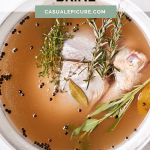This post may contain affiliate sales links. As an Amazon Associate, I earn from qualifying purchases. Please see my full disclaimer policy for details.
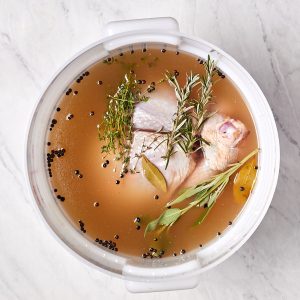
Enhance your holiday turkey with a simple yet essential preparation technique. Brining your turkey takes it to new heights. This method involves soaking the bird in a solution of broth, salt, sugar, and flavorful herbs and spices which locks in moisture, infuses incredible taste, and results in tender meat. Our simple turkey brine will allow you to say goodbye to dry, flavorless turkey and hello a mouthwatering masterpiece.
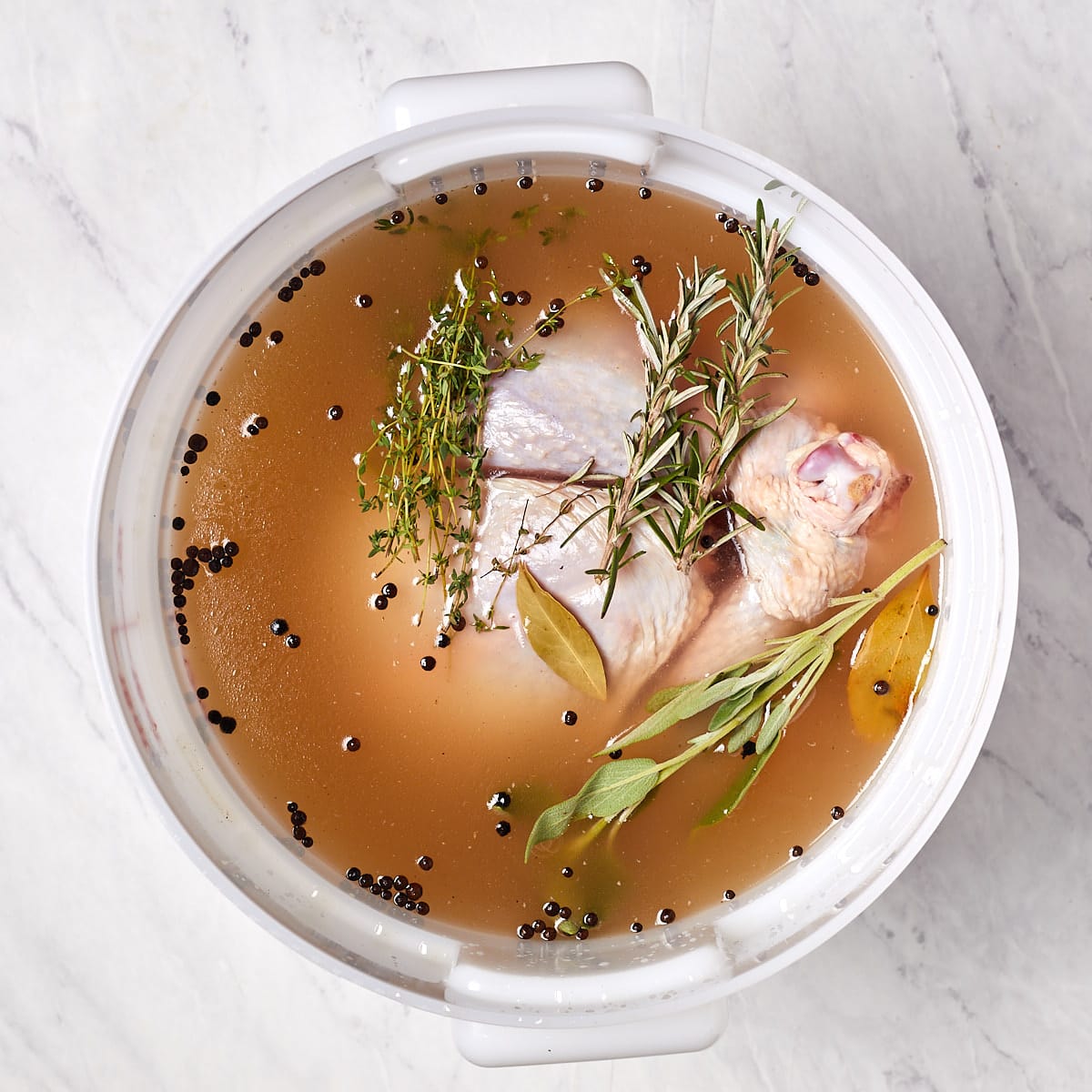
Why Brine a Turkey
Wet brining a turkey is an excellent technique for enhancing its taste and moisture. By soaking the turkey in a solution of broth, salt, sugar, and various herbs and spices, the meat absorbs the flavorful liquid. Brining adds moisture to the turkey, making it juicier, more tender, and flavorful when cooked. The salt also helps to season the meat throughout, while the herbs and spices impart a rich, aromatic flavor.
Wet vs Dry Brine – What’s the Difference
The primary difference between wet brining and dry brining lies in the method used to impart flavor, tenderness, and moisture to meat. Both use salt to help break down the protein which means less moisture is expelled during the cooking process.
- Wet Brine:
- Wet brining involves immersing the turkey in a saltwater solution combined with various flavor-enhancing ingredients like broth, sugar, herbs, and spices.
- The turkey is submerged in the brine mixture for an extended period, typically 12-24 hours.
- The brine penetrates the meat, imparting moisture, flavor, and seasoning throughout. It also helps break down muscle proteins for added tenderness.
- Wet brining requires a container large enough to hold the turkey and the brine. It’s a more immersive and hands-on process.
- Dry Brine (Also known as Dry Rub or Salt-Only Brine):
- Dry brining involves applying a mixture of salt and optional seasonings directly to the turkey’s surface, often under the skin and on the meat.
- The turkey is left uncovered in the refrigerator for an extended period typically 24-48 hours, allowing the salt to draw out moisture, which is later reabsorbed along with the seasonings.
- Unlike wet brining, there’s no immersion in a liquid solution. Dry brining is less messy and requires less space in the fridge.
- Dry brining still imparts moisture, flavor, and seasoning to the turkey but in a different way. It doesn’t break down proteins like wet brining but produces crispy skin due to the moisture removal.
What to Brine Your Turkey In
When brining a turkey, it’s important to use a food-safe container that is large enough to hold the turkey and the brine. Some common options are a food-grade plastic brining bag, large stock pot, brining bucket, cooler.
Regardless of the container you choose, ensure it’s made of food-grade materials and is clean and sanitized before adding your turkey and brine. It’s also important to keep the turkey and brine cold (40°F or lower) during the brining process, so make sure whatever you use to brine your turkey in will fit in the refrigerator or if you’re brining in a cooler make sure you have plenty of ice packs.
Key Ingredients and Variations
Besides the turkey there are two key ingredients in a brining solution: broth and salt. These ingredients form the foundation of a basic turkey brine, but there is lots of room for creativity and customization.
In the printable recipe below, you can find a complete list of ingredients and measurements.
- Turkey: You don’t need any special kind of turkey to brine and can brine a turkey breast.
- Broth: Both vegetable and poultry broth are good options, especially if you have some homemade broth on hand.
- Salt: For brining you should use kosher salt. It dissolves easily, has a pure, clean taste, and does not contain any additives like iodine or anti-caking agents that can affect the flavor of the brine.
- Sugar: Besides enhancing the flavor, sugar is used to balance the saltines and promote browning during roasting. The type of sugar can vary depending on your personal preference – white sugar, brown sugar, maple syrup, honey.
- Aromatics: We used a combination of rosemary, thyme, and sage, along with black peppercorns, bay leaves, and allspice.
While we prefer a straightforward brine, feel free to customize it with liquid flavorings like apple cider, white wine, or even a touch of soy sauce. You can easily introduce extra depth with aromatics such as garlic, onions, or zesty citrus slices. These components lay the groundwork for a fundamental turkey brine, leaving ample space for creative adjustments. Feel free to experiment with your favorite herbs, spices, or other flavorings. Just remember to strike the right balance in terms of salt and sugar proportions to avoid overly salty or sweet outcomes.
Salt to Liquid Brining Ratio
For a basic turkey brine, a common ratio is about 1 cup of kosher salt (or 3/4 of table salt) to 1 gallon of liquid (water or broth). This provides a good starting point, but you can adjust the amounts depending on your preferences and the size of your turkey. Keep in mind that it’s important to dissolve the salt in the liquid thoroughly.
How to Brine a Turkey
Here are the quick step-by-step instructions with visuals; you can find the full instructions with the exact ingredients in the recipe card below.
This post may contain paid affiliate sales links. As an Amazon Associate, I earn from qualifying purchases. Please see my full disclaimer policy for details.
Pro-tip: Brine your turkey in the refrigerator or a well-chilled cooler. The temperature should remain below 40°F to prevent bacterial growth.
1. Dissolve the Sugar and Salt: In a large pot, bring the turkey stock to a boil and then add salt and sugar, stirring until they dissolve. Once the sugar and salt have dissolved, add the bay leaves, peppercorns, and all spice berries. Remove the pot of brine from the heat and allow the it to cool to room temperature.
3. Brine the Turkey: Turkey should be thawed before brining. Remove the giblets and neck from the turkey cavity then pat it dry with paper towels. Place the turkey into a clean, food-grade plastic container, pot, or brining bag. Make sure it’s large enough to hold the turkey and the brine solution. Pour the cooled brine along with the ice water over the turkey, making sure it’s fully submerged. Add fresh rosemary, thyme, and sage sprigs to the turkey and brine. If the turkey is floating, you can use a heavy plate or a bag of ice to keep it submerged. Seal the bag or cover the container and place it in the refrigerator.
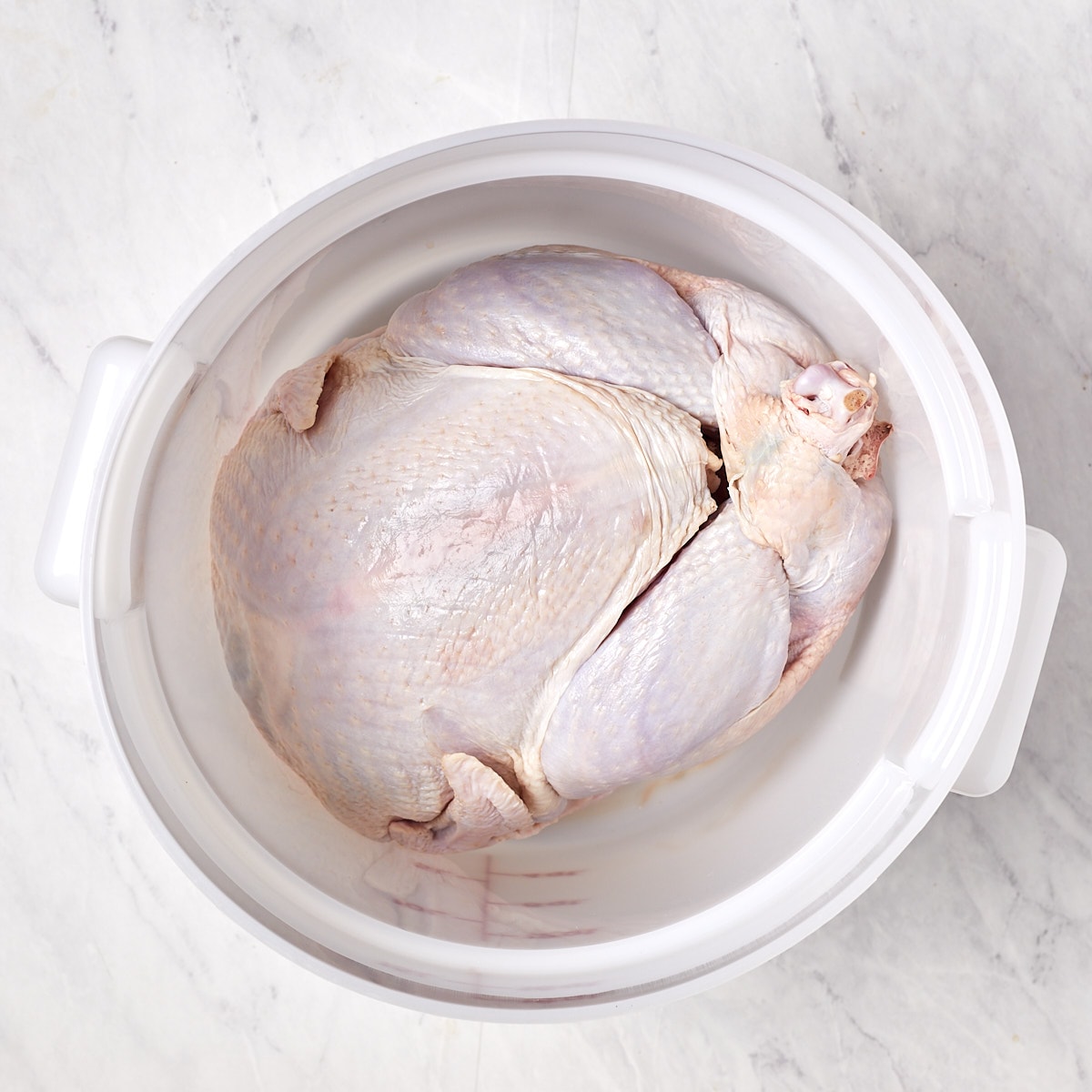

4. Refrigerate: Brine the turkey for approximately 1 hour per pound, but not less than 12 hours and not more than 24 hours. Longer brining can make the turkey too salty. Turn the bird once half way through brining. You can also use a cooler with ice packs to keep it at a safe temperature if your refrigerator doesn’t have enough. After the brining period is complete, remove the turkey from the brine, making sure to safely discard it afterwards as it is no longer usable.
5. Cook the Turkey: Once brined, the turkey is ready to be roasted, smoked, grilled, or prepared according to your favorite recipe.
How to Cook a Brined Turkey
Brining a turkey can add wonderful flavor and moisture to the meat, and there are several ways to cook a brined turkey. We love the traditional roasting method but we really enjoyed a grilled turkey. Grilling a brined turkey can infuse it with a delicious smoky flavor. Brined turkeys can also be fried, cooked on a rotisserie or smoked.
Whichever cooking method you choose, ensure the turkey reaches safe internal temperatures 165°F. Each method imparts its unique flavor and texture, so you can select the one that best suits your preferences and equipment.
Recipe Tips and Notes
- Keep it cold. While brining turkey, it is imporant to keep a safe temperature of 40°F or lower to prevent bacterial growth. This temperature range ensures that the turkey remains food-safe and doesn’t enter the “danger zone,” where bacteria can multiply rapidly.
- Plan ahead. Allow sufficient time for brining. The turkey should soak in the brine for about 1 hour per pound.
- Use a food-grade container. Choose a food-safe container, such as a large stockpot, food-grade plastic container, or brining bag, that’s large enough to fully submerge the turkey.
- Rest before cooking. Allow the turkey to air-dry in the refrigerator for a few hours or overnight. This helps to create a crispier skin when roasting.
- Don’t throw out the turkey neck and giblets. Instead turn them into a rich and delicious turkey gravy.
Frequently Asked Questions
While can technically brine a frozen turkey we don’t recommend it. Brining is most effective when done with a thawed turkey. Brining helps to infuse flavors and moisture into the meat, but when a turkey is frozen, the brine can’t penetrate the meat effectively due to the icy barrier.
No, it is not necessary to wash the turkey after it has been brined. If you choose to rinse make sure to do it in an empty sink and when you are done clean the sink thoroughly with hot soapy water.
The duration of turkey brining depends on the size of the turkey and the brine recipe you’re using. As a general guideline, you should brine a turkey for about 12 to 24 hours. For a 12-14 pound turkey we recommend brining for 12-18 hours and for a 16-20 pound turkey we recommend brining for 18-24 hours.
Yes, follow the same instructions as brining a whole turkey.
Brining a turkey in a cooler is a convenient method for those who have limited space in their refrigerator or if you’re cooking a very large turkey. Just ensure that the cooler is clean, well-sanitized, and capable of maintaining a cold temperature throughout the brining process. The turkey should be kept at 40°F or lower to prevent bacterial growth.
Yes, you can stuff a brined turkey, but be mindful of the levels of salt. Brining adds salt to the turkey, so be cautious about the amount of salt in your stuffing. Use unsalted or low-sodium ingredients, or reduce the salt content in your stuffing recipe to avoid an overly salty taste. Needless to say, do not stuff the turkey prior to brining.
YES! It is critical that the turkey maintain a safe temperature before being cooked. The USDA recommends to keep the turkey and brine at 40°F or lower.
It is not recommended to reuse a turkey brining solution. Once the solution has been used to brine a turkey, it may contain harmful bacteria from the raw poultry. Reusing it can pose a risk of cross-contamination and food-borne illness. It’s best to discard the brining solution after using it to brine a turkey and make a fresh one for the next use if needed.
Yes, you can brine other poultry such as chicken, duck, or game birds. The brining process works well for various poultry to enhance flavor and juiciness. The brine solution can be adjusted to suit the specific bird and your preferred flavors. Just like with turkey, the brining time for other poultry may vary based on the size of the bird. It’s important to follow similar food safety guidelines and recommendations for brining to ensure a delicious and safe end result.
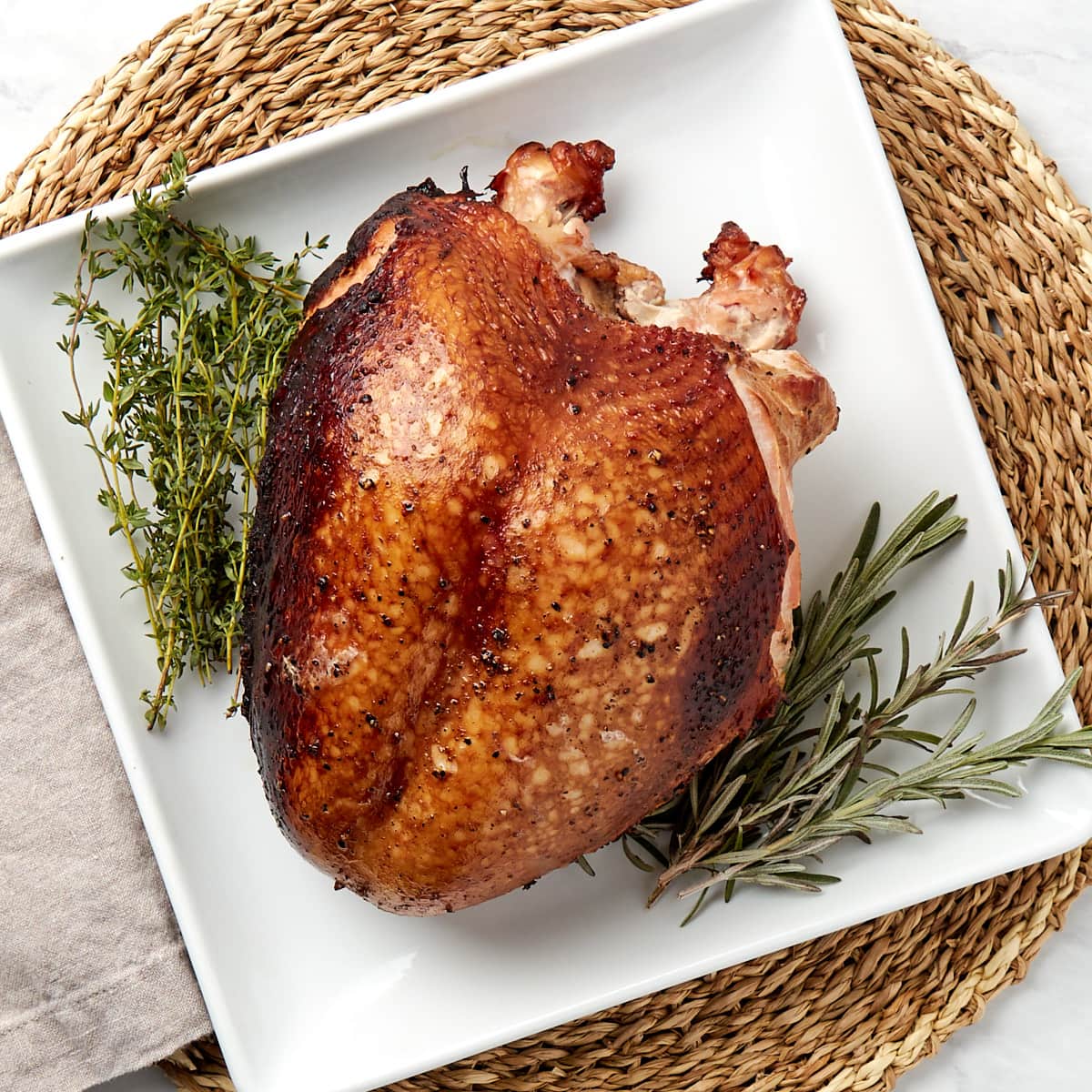
Thanksgiving Recipes To Try
Looking for more inspired holiday recipes? Try these other favorites:
- Turkey Neck Gravy – a rich and flavorful sauce that elevates any meal to the next level. Made from the pan drippings, turkey neck, and giblets it adds flavor to the turkey as well as your favorite dressing and mashed potatoes.
- Rosemary Garlic Mashed Potatoes – Made from a cream that is infused with fresh rosemary and garlic. Simple enough for weeknight dinners, yet elegant enough to impress at holiday gatherings.
- Grilled Turkey Breast – Using simple ingredients and techniques to create a tender, juicy turkey that’s perfect for any occasion. It’s perfect for festive holiday gatherings, a casual weekend dinner, or any time you want a delicious and satisfying meal.
Let’s Connect! If you make this recipe or any other recipe on Casual Epicure, please don’t forget to rate the recipe and leave a comment below. It helps others who are considering making our recipes and we love hearing about your cooking experiences. And if you snapped some shots, share them on Instagram, and be sure to tag @casual.epicure so we can feature them in our stories.
Simple Turkey Brine
This recipe may contain paid affiliate sales links. As an Amazon Associate, I earn from qualifying purchases. Please see my full disclaimer policy for details.
Equipment
- Brining Bags optional
Ingredients
- 12-14 pound whole turkey, thawed
- 8 cups turkey, chicken or vegetable broth
- 1 ½ cups kosher salt
- ½ cup sugar
- 2 bay leaves
- 1 tablespoon black peppercorns
- 1 ½ teaspoon all spice berries
- 1-2 sprigs fresh rosemary
- 1-2 sprigs fresh thyme
- 1-2 springs fresh sage leaves
- 1 gallon ice water, enough to cover turkey
Instructions
- In a large pot, bring the stock to a boil. Add salt and sugar, stirring until they dissolve. Add the bay leaves, peppercorns, and all spice berries.
- Remove the pot from the heat and allow the brine to cool to room temperature.
- Remove the giblets and neck from the turkey cavity. Pat it dry with paper towels.
- Place the turkey into a clean, food-grade plastic container, pot, or brining bag. Make sure it's large enough to hold the turkey and the brine solution.
- Pour the cooled brine along with the ice water over the turkey, making sure it's fully submerged. If the turkey is floating, you can use a heavy plate or a bag of ice to keep it submerged.
- Add fresh rosemary, thyme, and sage sprigs to the turkey and brine.
- Seal the bag or cover the container and place it in the refrigerator.
- Brine the turkey for approximately 1 hour per pound, but not less than 12 hours and not more than 24 hours. Longer brining can make the turkey too salty. Turn the bird once half way through brining. You can also use a cooler with ice packs to keep it at a safe temperature if your refrigerator doesn't have enough
- After the brining period is complete, remove the turkey from the brine. Discard the brine. Note: there is no need to wash the turkey before cooking.
- The turkey is ready to be roasted, smoked, grilled, or prepared according to your favorite recipe.

